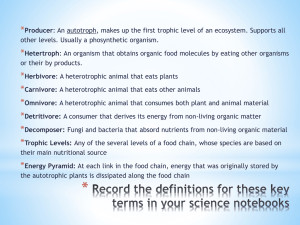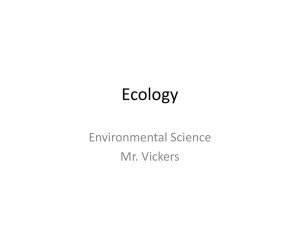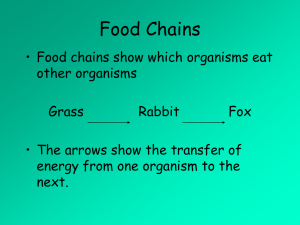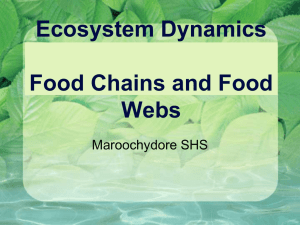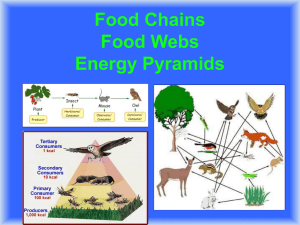1.4.6 Energy Flow
advertisement
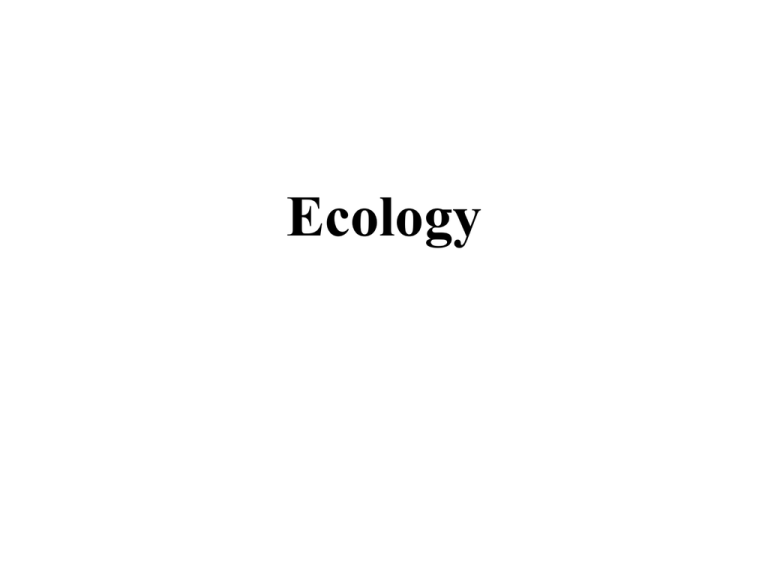
Ecology Objectives 1. To study new vocabulary associated with ecology i.e. ecology, biosphere, ecosystem, habitat, population, community 2. To outline the types of ecosystem available e.g. desert, rainforest, marine, grassland 3. To study one ecosystem in detail 4. To examine environmental factors that affect organisms 2 Objectives Name the sun as the primary source of energy. Name feeding as the pathway of energy flow. Present a grazing food chain. Present a food web. Construct a pyramid of numbers. Investigate how the Carbon cycle and the Nitrogen cycle operate Examine the human impact on an ecosystem Study how pollution occurs Define conservation and examine one conservation practice Study waste management in agriculture, fisheries and forestry Investigate how waste production can be controlled. 3 Some Ecology Definitions Ecology is the study of interactions between living things and their environment. Biosphere is the part of the planet containing living things. Ecosystem a group of organisms that interact with their environment together. 4 Habitat the place an animal or plant lives. Population members of the same species living in an area. Community all the different populations (species) in an area. 5 Environmental Factors Biotic factors living factors. Examples Food, competition,etc. Abiotic factors non-living factors. Examples Altitude, Aspect Climatic factors weather over a long time. Examples Temperature, rainfall Edaphic Factors Factors to do with soil. Examples pH, water content 6 What is an ecosystem? A community of living organisms interacting with one another and their non-living environment within a particular area, e.g. woodland, etc. 7 Energy Flow Ecosystems are unable to function unless there is a constant input of energy from an external source. Where does this energy come from? The Sun 8 Energy Flow This is the pathway of energy transfer from one organism to the next in an ecosystem due to feeding, e.g. along a food chain Feeding allows energy to flow from one organism to another in an ecosystem. 9 Energy Flow Plants catch the energy and change it into sugars. The plants are then eaten by consumers. These consumers get around 10% of the energy from the plant. If these consumers are eaten they pass on about 10% of their energy. Food chains can only be a certain length as the energy eventually runs out. 10 11 Energy flow in the ecosystem 12 Food Chain Is a flow diagram that begins with a plant and shows how food/energy is passed through a series of organisms in a community. Each organism feeds on the one before it. A food chain ends when there is not enough energy to support another organism. An example of a food chain: grass rabbit fox. 13 Learning check What is meant by primary source? Main source What is the primary source of energy? The sun 14 Grazing food chain A grazing food chain is one where the initial plant is living e.g. Grass grasshoppers frogs hawks Honeysuckle aphids ladybirds thrushes 15 A Detritus food chain A detritus food chain is one where the chain begins with dead organic matter and animal waste (detritus) e.g. Fallen leaves earthworms blackbirds hawks 16 Detritus Food Chain 17 Food Web A food web shows all the feeding connections in the habitat/ecosystem. Constructed by showing the links between all the interconnecting food chains in the habitat. 18 Food Web 19 Food Web a) Name a producer? b) Name a primary consumer? c) Name a secondary consumer? 20 Learning check Draw a woodland food web constructed using at least two food chains. 21 A woodland food web 22 Construct a two food chains (4 ‘links’) from the above food web Another food web 23 What is the longest food chain you can construct from this food web? Learning check What is meant by a Grazing food chain? • is a food chain where the initial plant is living Give an example 1. 2. Grass grasshoppers frogs hawks Honeysuckle aphids ladybirds thrushes 24 Producers Producers are organisms capable of making their own food by photosynthesis, e.g. green plants. Primary producers are the first members of a food chain 25 Consumers Consumers are organisms that feed on other organisms. They cannot make their own food. There are three types: • Primary consumers – feed on producers • Secondary consumers – feed on primary consumers • Tertiary consumers – feed on secondary consumers 26 Woodland food chain Honeysuckle aphids ladybirds thrushes Producer Primary consumer Secondary consumer Tertiary consumer 27 Learning check Construct a simple food web Two food chains e.g. Plant caterpillar thrush fox Plant earthworm blackbird fox Combine them to form a food web dandlion Caterpillar Thrush Earthworm Blackbird Fox 28 Trophic Level Trophic Level refers to the position of an organism in a food chain. Plants are at the 1st trophic level (T1) and Herbivores occupy the 2nd trophic level (T2). Carnivores that eat herbivores are at the 3rd trophic level (T3). The 4th trophic level (T4) is often occupied by the top carnivore. 29 Trophic levels 30 Pyramid of Numbers 31 Inverted Pyramid of Numbers This is where the number of organisms actually increases. 32 Learning check Explain the following terms: • Producer • organism capable of making its own food by photosynthesis • Consumer • organism that feeds on other organisms – cannot make their own food • Primary Consumer • organism that feeds on producers • Secondary Consumer • organism that feeds on primary consumers • Tertiary Consumer • organism that feeds on secondary consumers 33 Learning check What is meant by trophic level? This refers to the position of an organism in a food chain. T1 = 1st trophic level = Plants T2 = 2nd trophic level = Herbivores T3 = 3rd trophic level = Carnivores T4 = 4th trophic level = (T4) Top Carnivore. 34 Ecological Niche Ecological niche is the role an organism plays in the community. Two organisms with the same niche must compete with each other. e.g. magpies eat from gutters. Swallows eat in flight and thrushes eat at ground level. 35 Nutrient Recycling Carbon is recycled in nature. This is the Carbon Cycle. Plants take in carbon dioxide and make wood. When they die they release the carbon dioxide. Animals are made of carbon. We get carbon from eating plants and other animals. Microorganisms, like fungi and bacteria return carbon dioxide to the air by decomposing dead plants and animals. 36 Carbon Cycle 37 38 Three groups of organisms have roles in the carbon cycle 1. Plants remove carbon dioxide from environment through photosynthesis and return it by respiration 2. Animals obtain carbon by eating plants and return it to the air as carbon dioxide in respiration 3. Micro-organisms return carbon to the air as a result of breakdown of animals and plants 39 Nitrogen Cycle Nitrogen is the most abundant gas in air. It takes up 79% of the atmosphere. The Nitrogen is taken out of the air by Nitrogenfixing bacteria. The bacteria live on the roots of plants. They get food from the plants and they give the plants Nitrates. Without these bacteria no plants would grow. This relationship is called symbiotic as both organisms benefit. 40 41 Definitions Nitrogen Fixation is the conversion of nitrogen gas into ammonia (NH3), ammonium (NH4+) or nitrate (NO3-) Nitrification is the conversion of ammonia and ammonium (NH4+) compounds to nitrite and then to nitrate. Denitrification is the conversion of nitrates to nitrogen gas. 42 Nitrogen Fixing Bacteria Nitrogen fixing bacteria can be found free in the soil or maybe associated with the roots of certain plants e.g. Legumes. Legumes include clover, soya bean and peas. 43 Global Warming Since the 1970's Scientists have realised that the world's carbon dioxide % has been increasing. CO2 is produced mostly from burning fossil fuels. In the atmosphere carbon dioxide traps heat and warms up the planet. That's why it is called global warming. 44 Effects of Global Warming: 1.Warming oceans store the heat and ocean currents change. 2. When the currents heat and change they also Change the wind and rain patterns. This causes floods and droughts, stronger hurricanes and storms in different places. 45 Pollution Pollution is any harmful addition to the environment. Pollutants are substances that cause pollution. Types of pollution 1. Domestic pollution from houses 2. Agricultural pollution sprays, slurry on fields and in rivers 3. Industrial pollution smoke and fumes, acid rain Etc 46 Ozone Ozone depletion is an example of air pollution. Ozone (O3) is a gas that absorbs harmful ultraviolet (UV) light. A hole was first noticed in 1984 over Antarctica. There is also a hole at the Arctic, Australia and sometimes over Europe. Ozone loss is caused by, CFCs (ChloroFluroCarbons) in aerosols, freon gas in fridges and others 47 A decrease in Ozone causes skin cancers, damage to crops, damage to animals and plankton reduction which affects birds, fish, whales and oxygen levels. Control of Ozone loss CFCs are now banned and fridges are recycled carefully and not just dumped. 48 Conservation Conservation is the wise management of our existing natural resources. We use natural resources everyday and in some cases we exploit these natural resources. e.g. over fishing from the sea and growing plant species where they would not normally grow. The responsibility lies with individuals and big organisations to exercise control to prevent damage to habitats e.g. rainforests. 49 Extinction Amphibians Natterjack Toad The present rate of extinction is higher than at any time in the earths history. We have a duty Common Frog to future generations to pass on the natural Common Newt environment we have inherited. Reptiles Endangered species in Ireland: Common Lizard Leatherback turtle Mammals Invertebrates Badger, All Bat species, All Deer species Freshwater crayfish Hare species, Hedgehog, Otter Freshwater pearl mussel Pine Marten, Red Squirrel, Dolphin Kerry slug species Porpoise species, Seal species, Whale species Pygmy Shrew,Stoat 50 Benefits of Conservation 1. Prevents organisms from becoming extinct. 2. Maintains the balance of nature 3. Maintains a wide range of living things. 51 Examples of conservation • National parks • Hedgerow and bogland conservation • Listing of threatened species e.g. lizard, frog and stoat in Ireland • Zoos and wildlife parks – by breeding endangered species 52 You are required to study the effects and control of any one pollutant for Leaving Cert. from either fisheries, agriculture or forestry. 53 Conservation Practice from Fisheries a) Pollution of rivers, lakes and sea that kill fish – once depleted fish stocks take a long time to replace 54 b) Over fishing has reduced (and in some cases wiped out) fish stocks at sea. For this reason fish quotas (weight of each species of fish) have been imposed in many countries to try and ensure that enough fish are left in the sea to replenish stocks. c) Use of small mesh nets can result in too many young fish being caught which will reduce fish stocks. 55 Examples of conservation in fishing: 1. Size of mesh in nets is very important so only larger older fish are caught 2. Removal of pollution is very important so fish stocks are maintained. 56 Waste Management Modern living produces large amounts of waste e.g. household rubbish. Important to manage this waste to prevent pollution and conserve environment. Lets look at waste management in: a) Agriculture b) Fisheries c) Forestry 57 a. Agriculture Slurry (liquidified waste from farm animals) often pollutes lakes and rivers. Slurry contains high levels of minerals e.g. phosphorus and nitrogen. These minerals cause increased growth of algae in rivers and lakes causing algal blooms. When algae die they are decomposed by bacteria and the bacteria use up the oxygen in the water causing fish to die. 58 Addition of nutrients to fresh water is called eutrophication. We can reduced the amount of slurry getting into fresh water by: 1. Storing slurry in leak proof pits 2. Spreading slurry on dry land in summer rather than on rainy days. 59 2. Fisheries When fish are processed waste materials e.g. heads, tails, blood etc. are neutralised by adding formic acid and then pulped, dried and recycled as fertilisers or pig feed. 3. Forestry Waste materials include sawdust, small branches etc. Small branches can be spread on the forest floor to help machinery move more easily. These branches decay and add 60 nutrient back into the soil. Problems associated with waste disposal 1. Toxic chemicals released from wastes can contaminate water. 2. Waste disposed of in landfill sites can be unsightly and attract rats. Role of micro-organisms in waste management and pollution control 1. Landfill sites: Bacteria and fungi breakdown the organic waste. 2. Sewage: a) Primary sewage treatment involves physically screening waste and allowing it to settle. This removes large 61 objects and solids. b) Secondary treatment:Occurs when waste is broken down by bacteria and fungi. The waste is aerated to allow breakdown to occur. Secondary Treatment breaks down most of the organic matter. c) Tertiary treatment: Sometimes used to remove minerals e.g. phosphate and nitrates. Control of Waste Production “Reduce Reuse Recycle” 62 Reduce – Reduce your waste production by reducing your consumption of products you don’t really need. Reuse – Some things can be reused e.g. glass bottles can be re-used up to 40 times. Recycle – Many items can be recycled e.g. paper and plastic. Up to 40% of household waste is organic material that can be broken down by bacteria and earthworms to form compost. This compost can be added to soil to help plants grow. 63 2012 Paper > Section A > Question 4 Solutions 2012 Paper > Section C > Question 11




